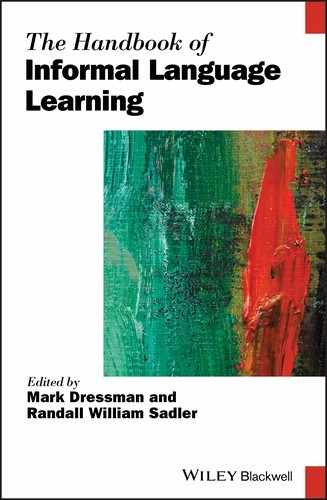Book Description
Provides a comprehensive and unique examination of global language learning outside of the formal school setting
Authored by a prominent team of international experts in their respective fields, The Handbook of Informal Language Learning is a one-of-a-kind reference work and it is a timely and valuable resource for anyone looking to explore informal language learning outside of a formal education environment. It features a comprehensive collection of cutting edge research areas exploring the cultural and historical cases of informal language learning, along with the growing area of digital language learning, and the future of this relevant field in national development and language education.
The Handbook of Informal Language Learning examines informal language learning from both theoretical and practical perspectives. Structured across six sections, chapters cover areas of motivation, linguistics, cognition, and multimodality; digital learning, including virtual contexts, gaming, fanfiction, vlogging, mobile devices, and nonformal programs; and media and live contact, including learning through environmental print, tourism/study abroad. The book also provides studies of informal learning in four national contexts, examines the integration of informal and formal classroom learning, and discusses the future of language learning from different perspectives.
- Edited by respected researchers of computer-mediated communication and second language learning and teacher education
- Features contributions by leading international scholars reaching out to a global audience
- Presents an exciting and progressive selection of chapters in a rapidly expanding field of research and teaching
- Provides a state-of-the-art collection of the theories, as well as the historical, cultural and international cases relating to informal language learning and its future in a digital age
- Covers 30 key topics that represent pioneering findings and new research
The Handbook of Informal Language Learning is an essential resource for researchers, students, and professionals in the fields of language acquisition, English as a second language, and foreign language education.
Table of Contents
- Cover
- Notes on Contributors
- Introduction
- Part I: Theorizing Informal Language Learning
- Part II: Learning in Digital Contexts
- Part III: Learning Through Media and Live Contact
- 12 Video and Informal Language Learning
- 13 Songs and Music
- 14 Mobility, Media, and Multiplicity: Immigrants' Informal Language Learning via Media
- 15 Service Sector Work and Informal Language Learning
- 16 Linguistic Landscapes and Additional Language Development
- 17 Language Tourism and Second Language Acquisition in Informal Learning Contexts
- Introduction
- Language gains deriving from language tourism
- Interacting with the host community
- The role of accommodation, leisure activities, and other travel components in facilitating SLA
- Alternative educational settings conducive to SLA
- SLA in work contexts
- Challenges and future research
- REFERENCES
- Part IV: International Case Studies of Informal Language Learners
- Part V: Informal Learning and Formal Contexts
- 23 Translanguaging Across Contexts
- 24 A Critical Review of Social Networks for Language Learning Beyond the Classroom
- 25 Digital Writing in Informal Settings Among Multilingual Language Learners
- 26 Extensive Reading for Statistical Learning
- 27 Leveraging Technology to Integrate Informal Language Learning within Classroom Settings
- Introduction
- The case for integrating informal learning into a language class
- Teacher support for informal language learning
- Strategies and tools for informal language learning: Focus on listening and vocabulary development
- Designing and evaluating informal language learning experiences
- Conclusion: The road ahead
- REFERENCES
- 28 Connecting Informal and Formal Language Learning
- Introduction
- Key concepts related to informal and autonomous language learning
- Benefits of informal autonomous language learning
- Self‐directed language learning and technology
- Underlying theoretical constructs associated with autonomous language learning
- Other factors that can foster or impede L2 learner autonomy
- Instructional approaches that encourage autonomous learning
- Autonomous learning within the classroom
- Autonomous language‐learning communities
- Non‐language oriented spaces and communities
- Benefits of participation in these online communities
- Potential dangers of online autonomous learning
- Resources available
- Suggestions for using these resources in the L2 classroom
- Conclusions: Making the formal informal again
- REFERENCES
- Part VI: The Present and Future of Informal Language Learning
- 29 Digital Translation: Its Potential and Limitations for Informal Language Learning
- 30 Future Directions in Informal Language Learning
- Introduction
- Understanding experiential language learning: A growing need
- Recreational language learning on the rise
- New opportunities for learning through games and social media
- Growing participation in nonformal, yet structured learning
- Classroom integration
- New devices and opportunities on the horizon
- The role of informal language learning in the future
- REFERENCES
- 31 Last Words: Naming, Framing, and Challenging the Field
- Index
- End User License Agreement
